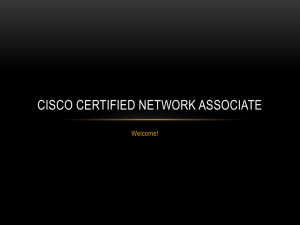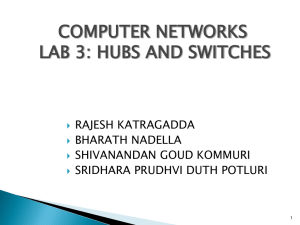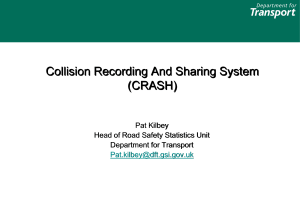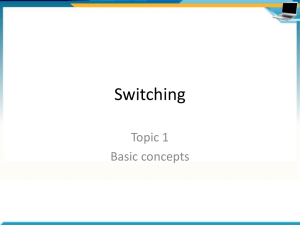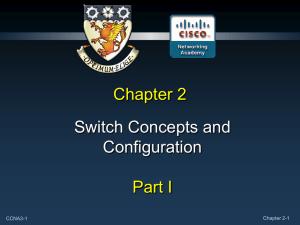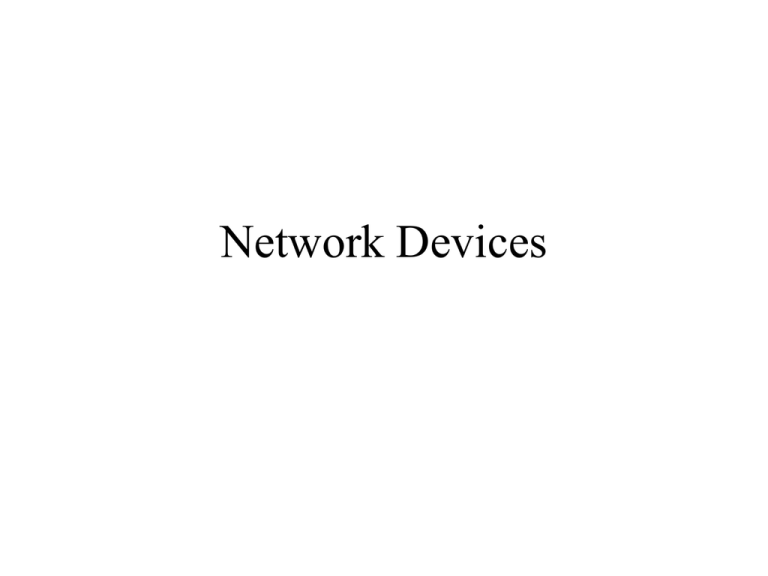
Network Devices
Repeaters
• A repeater regenerates a signal and
passes it on.
• It can also regenerate and retime
network signals at the bit level to allow
them to travel a longer distance on the
media
HUBS
• Hubs are multiport repeaters
– The difference between the two devices is
the number of ports
– While a repeater has just two ports, a hub
generally has from four to twenty-four ports
– Sometimes hubs are called concentrators
•Devices attached to a hub receive all traffic traveling through the
hub.
•The more devices there are attached to the hub, the more likely
there will be collisions.
•A collision occurs when two or more workstations send data over
the network wire at the same time.
•All data is corrupted when that occurs.
•Every device connected to the same network segment is said to
be a member of a collision domain.
Hubs And Collision Domains
Collision domain – The area of the network where a
host can receive a garbled message resulting from a
collision
More collision domains = better performance
How many collision domains exist in the graphic
shown?
ITE PC v4.0
Chapter 1
© 2007 Cisco Systems, Inc. All rights reserved.
Cisco Public
5
Bridges
• The bridge makes decisions about whether or not to pass
signals on to the next segment of a network
• When a bridge receives a frame on the network, the destination
MAC address is looked up in the bridge table to determine
whether to filter, flood, or copy the frame onto another segment
•There are times when it is necessary to break up a large LAN into
smaller, more easily managed segments.
•This decreases the amount of traffic on a single LAN and can extend
the geographical area past what a single LAN can support.
•The devices that are used to connect network segments together
include bridges, switches, routers, and gateways.
•Switches and bridges operate at the Data Link layer of the OSI
model.
•The function of the bridge or switch is to make intelligent decisions
about whether or not to pass signals on to the next segment of a
network.
•They makes these decisions based upon the layer 2 physical
address (MAC).
•A switch therefore has two main functions:
•switch data frames
•build and maintain tables
If placed strategically, a bridge can greatly improve network performance.
•If the destination device is on the same segment as the frame, the bridge blocks the frame
from going on to other segments. This process is known as filtering.
•If the destination device is on a different segment, the bridge forwards the frame to the
appropriate segment.
•If the destination address is unknown to the bridge, the bridge forwards the frame to all
segments except the one on which it was received. This process is known as flooding.
Switches
• A switch is sometimes described as a multiport bridge
• A bridge may have just two ports linking two network segments
• All switching equipment performs two basic operations.
– Switching data frames
– Building and maintaining switching tables
• Switching alleviates congestion and reduces traffic by increasing
the number of collision domains.
• Switches micro segment a network
Switches
A bridge or switch determines whether the frame should be forwarded to
the other network segment based on the destination MAC address.
A switch has many ports with many network segments connected to them. A switch
chooses the port to which the destination device or workstation is connected.
Ethernet switches are becoming popular connectivity solutions replacing hubs...
•reduces network congestion
•maximizes bandwidth
•reduces collision domain size
A SWITCH
SMARTER THAN A HUB
dedicated bandwidth out each port
no need to share with other ports (unlike a hub)
Can forward messages to a specific host by looking in
its MAC table
If destination MAC is not in its MAC table, floods the network out
all ports looking for a response
Only the host with the correct MAC address will respond
ITE PC v4.0
Chapter 1
© 2007 Cisco Systems, Inc. All rights reserved.
Cisco Public
14
More Stuff on Switches
How does the MAC table get built?
keeps track of frames being sent between hosts
records the information when there is a response
Collision Domains
each port on a switch is its own collision domain
8 port switch = 8 collision domains
ITE PC v4.0
Chapter 1
© 2007 Cisco Systems, Inc. All rights reserved.
Cisco Public
15
Router
Routers – directs traffic based on the destination IP
address
Routers build routing tables; switches build MAC
tables
Routers decode packets, switches decode frames
Look only the network portion of the IP address
finds the best path to take to get to the destination
Routers do not forward broadcasts!!!
ITE PC v4.0
Chapter 1
© 2007 Cisco Systems, Inc. All rights reserved.
Cisco Public
16
Default Gateway
Used when a host wants to send data to a host on a
different network.
Must be set on the workstation connected to the routing
device – the router interface connected to the PC
ITE PC v4.0
Chapter 1
© 2007 Cisco Systems, Inc. All rights reserved.
Cisco Public
17
NIC
• The function of a NIC is to connect a host device to the network
medium
• The NIC is also referred to as a network adapter
• NICs are considered Layer 2 devices because each NIC carries
a unique code called a MAC address

